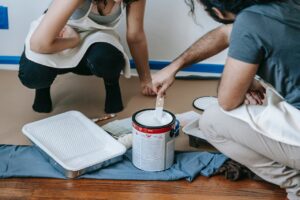Table of Contents
ToggleIntroduction: Why Choosing The Right Colors For Interior Painting Matters
Choosing the right colors for interior painting is crucial in creating a beautiful and harmonious living space. It can enhance the ambiance of the room, reflect your personality, and evoke specific emotions. Choosing the wrong colors, on the other hand, can make the room feel cramped, uninviting, and even affect your mood. This article will discuss the importance of choosing the right colors for interior painting and how it can impact your living space.
Psychology Of Colors: Understanding The Impact On Mood And Emotions
The use of color in interior painting goes beyond aesthetics. Different colors can have a profound impact on our mood and emotions. It is important to understand the psychology of colors when choosing the right colors for your home. For example, blues and greens are known to have a calming effect, making them great choices for bedrooms and bathrooms. Yellow can evoke feelings of happiness and energy, making it a good option for kitchens and living rooms. Reds and oranges can create a sense of excitement and warmth, making them ideal for accent walls or social spaces. By understanding the psychology of colors, you can create a space that not only looks great but also feels great to be in.
Color Trends: Staying Current Without Sacrificing Timelessness
When it comes to choosing colors for interior painting, it’s important to stay up-to-date with current trends while still ensuring a timeless look that won’t quickly become outdated. This can be a difficult balance to strike, but by paying attention to popular color palettes and trends in the design world, homeowners can choose colors that will look fresh and modern for years to come.
One approach to staying current with color trends is to look to professional design resources, such as interior design magazines or online design blogs. These resources often showcase the latest trends in color palettes and can provide inspiration for unique and modern color combinations.
It’s also important to keep in mind that while bold, statement-making colors may be trendy in the moment, they may not stand the test of time. To ensure a timeless look, consider incorporating trendy colors as accents or in smaller, more easily changeable elements, such as throw pillows or curtains.
Coordinating Color Schemes: Achieving Cohesion And Balance
Coordinating color schemes is an essential aspect of interior painting that should not be overlooked. A well-coordinated color scheme can make a room look cohesive and balanced, while a poorly coordinated one can make it look chaotic and unappealing. One popular method for coordinating color schemes is to use the color wheel.
The color wheel is a tool that shows the relationships between different colors. Colors that are next to each other on the wheel are known as analogous colors and are often used together to create a harmonious look. On the other hand, colors that are opposite each other on the wheel, such as blue and orange, are known as complementary colors and can be used to create a bold, eye-catching look.
Another approach to coordinating color schemes is to use a neutral base color, such as white or beige, and then add pops of color through accents like pillows, curtains, and artwork. This can create a cohesive look while still allowing for some flexibility in adding color. It’s important to consider the existing elements in the room, such as furniture and flooring, when selecting a color scheme. Coordinating the colors with these elements can help create a unified look.
Considering Lighting And Space: Making The Most Of Your Interior Colors
When choosing colors for interior painting, it is important to consider the lighting and space of the room. Natural light, artificial light, and the size of the space can all affect how colors appear. A room with ample natural light may be able to handle darker or bolder colors without feeling too overwhelming, while a smaller space with less natural light may benefit from lighter or softer colors to make the room feel more open and airy.
It is also important to consider the purpose of the room and the mood you want to create. For example, a bedroom may benefit from calming and relaxing colors such as blues or greens, while a home office may benefit from energizing and stimulating colors such as yellows or oranges.
In addition, the color scheme should also be coordinated to achieve cohesion and balance throughout the space. This involves selecting colors that complement each other and work well together to create a harmonious overall look. Using a color wheel or seeking the advice of a professional can help ensure that the colors chosen work together effectively.
Testing And Sampling: Avoiding Costly Mistakes
When it comes to choosing the right colors for your interior painting project, it’s important to test and sample the colors before making a final decision. This is especially important when dealing with multiple colors or accent walls. By testing and sampling, you can avoid costly mistakes that may arise from choosing the wrong color or shade. Sampling allows you to see how the color looks in different lighting conditions and how it works with the other colors in the room. It also helps you to see how the color will look on a larger scale, as a small swatch may not give you an accurate representation.
Testing the color on the wall is also important, as the color may appear different on the wall than it does on a sample or swatch. This can be done by painting a small section of the wall or by using a removable wallpaper in the chosen color. By taking the time to test and sample your colors, you can ensure that you are making the right decision and avoid the expense of having to repaint or redo the work.
Conclusion: The Art And Science Of Choosing Interior Paint Colors
Choosing the right colors for interior painting is a crucial step in achieving the desired look and feel of your home. From the psychology of colors to color trends and coordinating schemes, the process involves both art and science. Considerations such as lighting and space, as well as testing and sampling, can help you avoid costly mistakes. When choosing interior paint colors, it’s important to remember that colors can influence mood and emotions. Understanding the psychology of colors can help you create the atmosphere you desire. Keeping up with color trends can help you stay current without sacrificing timelessness.
Coordinating color schemes is also essential for achieving cohesion and balance in your home’s interior design. By considering factors such as lighting and space, you can make the most of your interior colors and enhance the overall look of your home. Finally, testing and sampling your chosen colors can help you avoid costly mistakes and ensure that you’re happy with the final result. Ultimately, choosing the right colors for your interior painting project requires a thoughtful and intentional approach. By taking the time to consider all of the relevant factors and working with a professional if needed, you can achieve a beautiful and cohesive interior design that reflects your personal style and tastes.
Our Experts’ Take
Many interior designers and professional painters agree that selecting the right colors for interior painting is crucial for achieving the desired atmosphere and enhancing the overall aesthetic appeal of a space. They stress the importance of understanding the psychological effects of colors, considering lighting and space, and testing and sampling colors before making a final decision. They also recommend seeking professional guidance and advice to avoid costly mistakes and achieve the desired outcome.
Source: This Old House | The Spruce | Peintre Prestige
Do You Need A Professional Interior Painting Team You Can Trust?
Looking to give your space a fresh new look? Say goodbye to boring walls and hello to the experts at PaintMasters – your go-to interior painter in Concord, California! With over 25 years of experience in the business, we’ve perfected the art of transforming any space into a work of art.
From custom home interiors to commercial office spaces and restaurants, our team of skilled professionals has the knowledge and expertise to tackle any project with ease. We’re not your average interior painter – we use the latest cutting-edge technology and a state-of-the-art 15,000 CFM spray booth to ensure that every detail is absolutely perfect.
Whether you’re looking for interior or exterior painting, deck staining, acoustic removal, drywall repair, or texturing, we’ve got you covered. At PaintMasters, we’re committed to using only the highest quality materials and providing unbeatable quality workmanship on every job.
So why should you choose us for your next project? It’s simple – we’re passionate about what we do and committed to delivering a flawless finish every single time. Whether you’re looking to revamp a tired old room or add a unique touch of style to a brand new space, we’re here to help you achieve your vision.
Don’t settle for anything less than the best. Trust the experts at PaintMasters to transform your home or business into the space of your dreams. Contact us today to get started on your next interior painting project!


